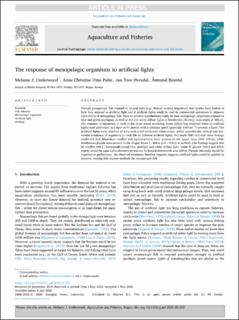The response of mesopelagic organisms to artificial lights
Peer reviewed, Journal article
Accepted version
Date
2020Metadata
Show full item recordCollections
- Articles [3012]
- Publikasjoner fra CRIStin [3070]
Abstract
Though mesopelagic fish respond to natural light (e.g., diurnal vertical migration), few studies have looked at how they respond to artificial light and if artificial lights could be used in commercial operations to improve catchability of mesopelagic fish. Here we present a preliminary study on how mesopelagic organisms respond to blue and green spotlights, as well as red and white diffuse lights in Masfjorden (Norway; max depth of 480 m). The response of organisms in each of the three sound scattering layers (SSLs) was observed when a) artificial lights were positioned in a layer or b) moved with a constant speed (generally 0.03 ms−1) towards a layer. The artificial lights were attached to a rig with a self-contained echosounder, which recorded the vertical and horizontal avoidance of organisms in each SSL to different artificial lights. Net hauls (MIC-net) and video footage confirmed that Maurolicus muelleri and siphonophores were present in the upper layer (100–150 m), while Benthosema glaciale were present in the deeper layers (∼200 m and ∼300 m to seabed). Our findings suggest that M. muelleri (SSL1) horizontally avoid blue spotlight and white diffuse light, while B. glaciale (SSL2 and SSL3) mainly avoid the same lights downwards and can be herded downwards over 250 m. Though this study should be regarded as preliminary, the observed avoidance/herding response suggests artificial lights could be applied to improve existing fish capture methods for mesopelagic fish.
